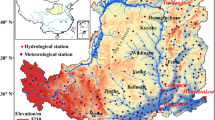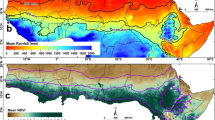Abstract
As a monsoon climate dominated region, East Asia has a high rate of climate variation. Previous studies demonstrated that the East Asian monsoon had weakened since the end of 1970’s; however, contrary to the climatic trend, a common scenario of advancing farming-pastoral ecotone (FPE) has been proposed. The objective of this study is to analyze land surface changes in association with monsoon climate variability over past 25 years in East Asia. A combination of intensive ground survey of vegetation and land use, meteorological data, and remote sensing are used to quantify the relationship between vegetation and climate and to analyze the FPE fluctuations associated with changing climate. Field precipitation data from 1981 to 2005, are used to represent climate variations and to delineate the FPE boundary. NDVI data are used to evaluate greenness-precipitation linkages by vegetation type and to create land cover maps depicting spatial pattern fluctuations of the FPE. This study demonstrates that: (1) There was no persistent northwest shifting trend of either the FPE boundary or vegetation cover during last 25 years. (2) Time integrated NDVI (TI-NDVI) varies with precipitation, and the maximum or minimum NDVI may be only sensitive to precipitation for areas with mean annual precipitation lower than approximately 200 mm. (3) A significant relationship exists between NDVI and precipitation variations for areas with mean annual precipitation greater than approximately 300 mm, especially the ecotone with a ΔNDVI of 0.122 ± 0.032. (4) The “advances” of FPE closely mimic fluctuations of precipitation in East Asia.





Similar content being viewed by others
References
Allen CD, Breshears DD (1998) Drought-induced shift of a forest-woodland ecotone: rapid landscape response to climate variation. Proc Natl Acad Sci 95:14839–14842
Bethany BA, Mustard JF (2005) Identifying land cover variability distinct from land cover change: cheatgrass in the Great Basin. Remote Sens Environ 94:204–213
Bonham CD (1989) Measurement for terrestrial vegetation. Wiley, New York, 338pp
Chambers N (2002) Effects of climate change on terrestrial biodiversity. Bio, 217, ecology and global change. Duke University, Durban
Churkina G, Svirezhev Y (1995) Dynamics and forms of ecotone of under the impact of climatic change: mathematical approach. J Biogeogr 22:565–569
Crumley CL (1993) Analyzing historic ecotonal shifts. Ecol Appl 3:377–384
Ding YH, Wang ZY, Sun Y (2008) Inter-decadal variation of the summer precipitation in East China and its association with decreasing Asian summer monsoon. Part I: observed evidences. Int J Climatol 28:1139–1161
Donohue RJ, McVicar TR, Roderick ML (2009) Climate-related trends in Australian vegetation cover as inferred from satellite observations, 1981–2006. Glob Chang Biol 15:1025–1039
Fang XQ (1999) Decline of pre-historical agriculture and formation of farming grazing transitional zone in north China: a view from climatic changes. J Nat Res 14:212–218
Farina A (2006) Principles and methods in landscape ecology: toward a science of landscape. Springer, Dordrecht, p 412
Forman RTT (1995) Some general-principles of landscape and regional ecology. Landsc Ecol 10:133–142
Fortin MJ, Olson RJ, Ferson S (2000) Issues related to the detection of boundaries. Landsc Ecol 15:453–466
Fu CB, Wen G (1999) Variation of ecosystems over East Asia in association with seasonal, interannual and decadal monsoon climate variability. Clim Chang 43:477–494
Herrmann SM, Anyamba A, Tucker CJ (2005) Recent trends in vegetation dynamics in the African Sahel and their relationship to climate. Glob Environ Chang 15:394–404
Huang C, Davis LS, Townshend JRG (2002) An assessment of support vector machines for land cover classification. Int J Remote Sens 23:725–749
Hufkens K, Scheunders P, Ceulemans R (2009) Ecotones in vegetation ecology: methodologies and definitions revisited. Ecol Res 24:977–986
Karka S, van Rensburg BJ (2006) Ecotones: marginal or central areas of transition? Israel J Ecol Evol 52:29–53
Koch GW, Vitousek PM, Steffen WL, Walker BH (1995) Terrestrial transects for global change research. Vegetatio 121:53–65
Krummel JR, Gardner RH, Sugihara G et al (1987) Landscape patterns in a disturbed environment. Oikos 48:321–324
Le Houérou HN (1996) Climate change, drought and desertification. J Arid Environ 34:133–185
Liu JH, Gao JX, Lv SH et al (2011) Shifting farming-pastoral ecotone in China under climate and land use changes. J Arid Environ 75:298–308
Metzger JP, Muller E (1996) Characterizing the complexity of landscape boundaries by remote sensing. Landsc Ecol 11:65–77
Neilson RP (1993) Transient ecotone response to climate change: some conceptual and modeling approaches. Ecol Appl 3:367–368
Ni J, Zhang XS (2000) Climate variability, ecological gradient and the Northeast China Transect (NECT). J Arid Environ 46:313–325
Nicholson SE (1993) A re-evaluation of rainfall variability in the Sahel Part I: characteristics of rainfall fluctuations. Int J Climatol 13:371–389
Nicholson SE, Davenport ML, Malo AR (1990) A comparison of the vegetation response to rainfall in the Sahel and East Africa, using normalized difference vegetation index from NOAA AVHRR. Clim Chang 17:209–241
Ou TH, Qian WH (2006) Vegetation variations along the monsoon boundary zone in East Asia. Chin J Geophys 49:698–705
Qian WH, Lin X, Zhu YF et al (2007) Climatic regime shift and decadal anomalous events in China. Clim Chang 84:167–189
Ramage C (1971) Monsoon meteorology. Academic, New York, p 269
Rian S, Xue YK, MacDonald GM (2009) Analysis of climate and vegetation characteristics along the Savanna-Desert ecotone in Mali using MODIS data. GIScience Remote Sens 46:424–450
Shi PJ, Ha S (2002) Comparison between Holocene environmental changes in north China agro-pastoral zone and Africa Sahelian belt. Earth Sci Front 9:121–128
Slayback D, Pinzon J, Los SO et al (2003) Northern hemisphere photosynthetic trends 1982 1999. Glob Chang Biol 9:1–15
Tang GC (2006) Application of grazing ban and rest grazing in Inner Mongolia. China Anim Husb Bull 9:6–7
Tucker CJ, Dregne HE, Newcomb WW (1991) Expansion and contraction of the Sahara desert from 1980 to 1990. Science 253:299–301
Vapnik VN (1995) The nature of statistical learning theory. Springer, New York
Walther G, Post E, Convey P et al (2002) Ecological responses to recent climate change. Nature 416:389–395
Wu TF, Lin CJ, Weng RC (2004) Probability estimates for multi-class classification by pairwise coupling. J Mach Learn Res 5:975–1005
Xu M, Chang CP, Fu C et al (2006) Steady decline of East Asian Monsoon winds, 1969–2000: evidence from direct ground measurements of wind speed. J Geophys Res 111, D24111. doi:10.1029/2006JD007337
Ye Y, Fang XQ (2012) Expansion of cropland area and formation of the eastern farming-pastoral ecotone in northern China during the twentieth century. Reg Environ Chang. doi:10.1007/s10113-012-0306-5
Zhang XS, Sun SZ, Yong SP et al (2007) Vegetation map of China and its geographic pattern. Geological Publishing House, Beijing, p 1228
Zhao SQ (1953) Chabei, Chameng, Ximeng-An economic geography investigation of farming-pastoral region of Northern China. Acta Geograph Sin 19:43–60
Acknowledgments
This study was supported by the National Basic Research Program of China (Grant No. 2009CB723904 and 2012CB956202). We thank NASA GIMMS team for providing the most updated AVHRR GIMMS dataset.
Author information
Authors and Affiliations
Corresponding author
Rights and permissions
About this article
Cite this article
Lu, W., Jia, G. Fluctuation of farming-pastoral ecotone in association with changing East Asia monsoon climate. Climatic Change 119, 747–760 (2013). https://doi.org/10.1007/s10584-013-0761-0
Received:
Accepted:
Published:
Issue Date:
DOI: https://doi.org/10.1007/s10584-013-0761-0




